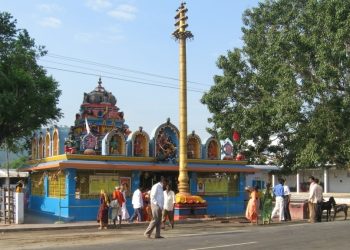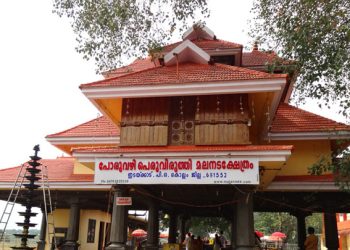Shri Mayureshwar Mandir or Shri Moreshwar Mandir is a Hindu temple dedicated to Ganesha, the elephant-headed god of wisdom. It is located in Morgaon in Pune District, about 80 kilometres away from Pune city in the Indian state of Maharashtra. The temple is the starting and ending point of a pilgrimage of eight revered Ganesha temples called Ashtavinayaka.
Shrine’s History
Morya Gosavi, a prominent Ganapatya saint, worshipped at the Morgaon Ganesha temple before shifting to Chinchwad, where he established a new Ganesha temple. The Morgaon temple and other Ganapatya centres near Pune enjoyed royal patronage from the Brahmin Peshwa rulers of the Maratha Empire during the 18th century. The Peshwas, who worshipped Ganesha as their kuladaivat, donated in land and/or cash and/or made additions to these Ganesha temples. According to Anne Feldhaus, the Morgaon temple does not pre-date the seventeenth century, when Morya Gosavi popularised it. However, even the dating of Morya Gosavi is disputed and varies from the 13th?14th century to the 17th century. The descendants of Morya Gosavi ? who were worshipped as Ganesha incarnates at the Chinchwad temple ? often visited the Morgaon temple and controlled the finances and administration of many Ashthavinayak temples. The 17th-century saint Samarth Ramdas composed the popular arati song Sukhakarta Dukhaharta, seeing the Morgaon icon. Currently, the temple is under the administration of the Chinchwad Devasthan Trust, which operates from Chinchwad. Besides Morgaon, the temple trust controls the Chinchwad temple and the Theur and Siddhatek Ashtavinayak temples

Legends Associated with This Shrine
According to the Ganesha Purana, Ganesha incarnated as Mayuresvara or Mayureshwar, who has six arms and a white complexion. His mount is a peacock. He was born to Shiva and Parvati in the Treta yuga, for the purpose of killing the demon Sindhu.
Sindhu was the son of Chakrapani ? the king of Mithila and his wife Ugra. Ugrā conceived due to the power of a solar mantra but was unable to bear the extreme heat radiating from the foetus, so she abandoned it in the ocean. Soon, a son was born from this abandoned foetus and the ocean returned him to his grieving father, who named him Sindhu ? the ocean.
Parvati underwent austerities meditating on Ganesha ? “the supporter of the entire universe” ? for twelve years at Lenyadri. Pleased by her penance, Ganesha blessed her by the boon that he would be born as her son. In due course, Ganesha was born to Parvati at Lenyadri and named as Ganesha by Shiva. Little Ganesha once knocked an egg from a mango tree, from which emerged a peacock. Ganesha mounted the peacock and assumed the name Mayuresvara.
Sindhu was given the ever-full bowl of amrita as a boon from the Sun-god. The demon was warned that he could drink from the bowl as long as it was intact. So to protect the bowl, he swallowed it. Sindhu terrorised the three worlds, so the gods asked Ganesha for help. Ganesha defeated Sindhu’s army, cut his general Kamalasura into three pieces and then cut open Sindhu’s body, emptying the Amrita bowl and thus killing the demon. The creator-god Brahma is described as having built the Morgaon shrine and marrying Siddhi and Buddhi to Ganesha. At the end of this incarnation, Ganesha returned to his celestial abode, giving his peacock mount to his younger brother Skanda, with whom the peacock mount is generally associated.
Because Ganesha rode a peacock, he is known as Mayureshwar or Moreshwar. Another legend says that this place was populated by peacocks giving the village its Marathi name, Morgaon, and its presiding deity the name Moreshwar.
A Ganapatya legend recalls how the creator-god Brahma, the preserver-god Vishnu and the dissolver-god Shiva, the Divine Mother Devi and the Sun-god Surya mediated at Morgaon to learn about their creator and their purpose of existence. Ganesha emerged before them in form of an Omkara flame and blessed them. Another legend records that when Brahma created his son The Kama, he became a victim of desire and lusted for his own daughter Sarasvati (Goddess of learning). Upon invocation by all of the deities, the sacred Turiya Tirtha river appeared and Brahma bathed in her waters to cleanse his sin of incest. Brahma then came to Morgaon to worship Ganesha, carrying water from the river in his water pot. Entering the Ganesha shrine, Brahma stumbled and water fell from the pot. When Brahma tried to pick it up, it was turned into the sacred Karha river, that still flows at Morgaon

Architectural Relevance of This Shrine
The temple is surrounded by a tall stone boundary wall with minarets at each of the four corners, suggesting a Muslim influence on the architecture. A Muslim chieftain was patron of the temple at one time. The temple has four gates, each facing a cardinal direction and with an image of Ganesha, each gate depicting him in the form that he appeared in each of the four ages. Each of the four Ganesha forms is associated with a Purusartha and accompanied by two attendants. The image of Ballalvinayaka at the eastern gate, accompanied by god Rama and his consort Sita, symbolises Dharma and embodies the preserver-god Vishnu. Vignesha at the southern gate, flanked by Ganesha’s parents Shiva and Parvati symbolises Artha and embodies the dissolver ? Shiva. Cintamani at the western gate ? representing The Kama ? is attended by the love god Kamadeva and his wife Rati and embodies the formless Brahman. Mahaganapati at the northern gate standing for moksha is accompanied by Varaha and his wife the earth goddess Mahi embodies Sat Brahman. The main entrance of the temple faces north.
The quadrangular courtyard has two Deepmalas ? lamp towers with niches to light lamps. A sculpted 6 foot mouse ? the vahana of Ganesha sits in front of the temple. A Nagara-khana ? which stores Nagaras ? is situated nearby. A huge Nandi bull sculpture is positioned facing the Lord, just outside the temple gates. This is considered unusual as a Nandi is normally positioned in front of the sanctum sanctorum in Shiva temples. A legend explains this oddity: the Nandi sculpture being transported from nearby Shiva temple, decided to settle in front of Ganesha and then refused to move. Both the mouse and Nandi are considered guardians of the entrance. A recently built sabha-mandapa has idols of god Vishnu and his consort Lakshmi. It leads to central hall built by the Patwardhan Rulers of Kurundwad. The ceiling of this hall is formed from a single stone. The garbhagriha has a central image of Ganesha as Mayureshwar or Moreshwar, facing the North. The Ganesha image is depicted in a seated posture with its trunk turning to the left, four arms and three eyes. He holds a noose and elephant goad in his upper hands, while his lower right rests on his knee and the other one holds a modaka. The navel and the eyes are embedded with diamonds.
A cobra hood raised over Ganesha’s head, shelters the Lord. The image is actually smaller than it looks as it is smeared with a thick level of saffron-coloured Sindoor (vermillion), which peels off once every century. It last fell off in 1882, and prior to that in 1788. Ganesha is flanked by idols of his consorts Riddhi and Siddhi sometimes called Siddhi and Buddhi. These idols are made of an alloy of five metals or of brass. The deities are covered with crafted silver and gold. Like all Ashtavinayaka shrines, the central Ganesha image is believed to be svayambhu, naturally occurring in the form of an elephant-faced stone. In front of the central image, the vahanas of Ganesha ? the mouse and the peacock are placed. To the left outside the garbhagriha is an image of Nagna-Bhairava.
The space around the sabha-mandapa has 23 different idols depicting various forms of Ganesha. The Ganesha idols include the images of the eight avatars of Ganesha described in Mudgala Purana ? Vakratunda, Mahodara, Ekadanta, Vikata, Dhrumavarna, Vighnaraja and Lambodara ? positioned in eight corners of the temple. Some of the images are installed by the Yogendra Ashram followers. One more noteworthy Ganesha idol is of “Sakshi Vinayaka” who is “a witness” to the prayers offered to Mayureshwara.
Traditionally, first “Nagna Bhairava” is prayed then Mayureshwara and then Sakshi Vinayaka. This is the perfect sequence for prayers offered here. There are other images of Hindu deities around the sabha-mandapa including those of the regional deities Vithoba and Khandoba, personifications of Shukla chaturthi and Krishna chaturthi and the Ganapatya saint Morya Gosavi. On the circumambulation path, there is a Tarati tree near the Kalpavrushka Mandir. The tree is believed to be the spot where Morya Gosavi underwent penance. There are two sacred trees in the courtyard: shami and bilva.
Shrine’s Map Location and How to Go There
By RoadThe nearest Bus stop is Morgaon.By RailThe nearest railway station is Jejuri which is only 15 km.By Air
The nearest airport is the Pune airport.
Shrine Timings
The central icon of Ganesha is worshipped daily: at 7 am, 12 noon and at 8 pm.
Events Celebrated at This Shrine
On Ganesh Jayanti and Ganesh Chaturthi festivals on the 4th lunar day of the bright fortnight of the Hindu months Magha and Bhadrapada respectively, devotees flock to the Mayureshwar temple in large numbers. On both occasions, a procession of pilgrims arrives from Mangalmurti temple, Chinchwad with the palkhi of Ganesha. The Ganesha chaturthi celebrations last for more than a month, until Ashvin Shukla. Fairs and celebrations also occur on Vijayadashami, Shukla Chaturthi, Krishna Chaturthi and Somavati Amavasya.













































